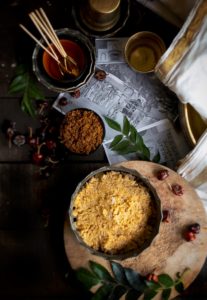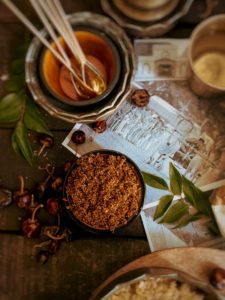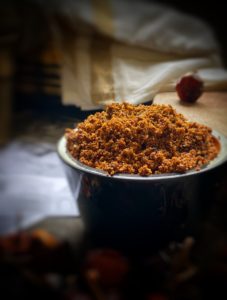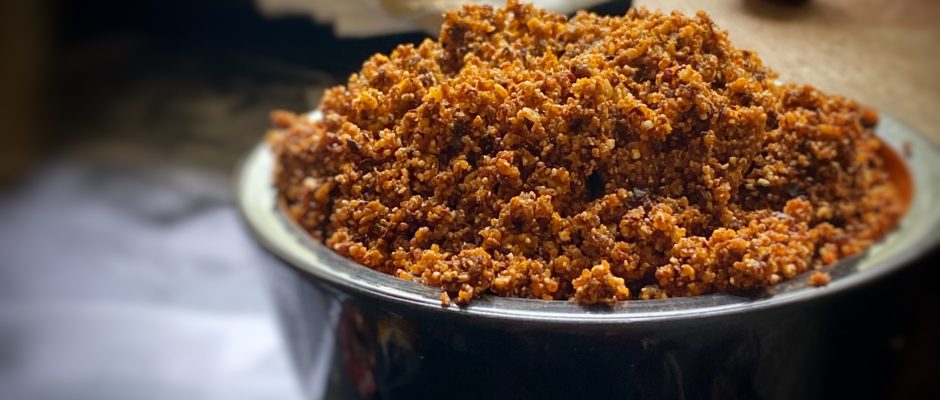Simplicity Coimbatore, Selavu molagupodi </a
I grew up hearing the names of these places often ; Modakurichi , Palayakottai , Uthukuli , Samathur … I would listen in rapt attention while my parents chatted with their friends (from the Gounder clans) who own elaborate ancestral homes in these villages .
We often hear of the term “friends like family”. There’s no better way for me to describe the relationship my family shares with members of this community .
The bonding (for my siblings and me) usually happened around summer time when schools were off and we all converged in the Nilgiris for 2 whole months ,enjoying the pristine outdoors of the Blue Mountains!
Only ,we didn’t know back then that we were so lucky to be able to unwind in the hills for so long. Today it is an unimaginable luxury.

The cuisine served in the Gounder homes was born out of a lifestyle which consisted of farming, hunting and travel. I guess we can say that it is unique. There are several dishes which are not found in any other cuisine of Tamil Nadu. One dish which I must mention is the ‘molagupodi saadham‘ from Palayakottai. It is pronounced “molagu podi” with a u.
It is a dish which I tasted for the first time in January this year. It was the Crafts Council of India ‘s National meet and we were hosting delegates from all over the country. Lunch was a traditional vegetarian spread on the banana leaf and there was hushed excitement about this molagupodi saadham which was part of the menu.
As we members walked up and down the length of the tables to ensure that the guests ate well, we heard everyone praising this particular dish and asking for seconds.
It was hard to imagine why this pale coloured rice dish was generating so much of buzz in the dining room. We couldn’t wait to taste it ! When it was our turn to sit down for the meal ,the first thing we asked for was the molagupodi saadham. One mouthful was enough to realise that it was a taste so special that we were unable to single out any one specific ingredient. The flavours were well rounded and the palate insisted on another helping ! It was served hot and the texture was creamy and comforting. The kind of satisfaction the stomach and soul received was similar to that of eating a home-made sambhar saadham or paruppu sapaadu with lots of ghee.
Ever since the rains started, we have been cooking dishes,at home, which were missing from the summer menu. Kollu parupu , milagu rasam, sukkuti keerai poriyal etc. My cousin had also sent me a spicy garlic podi which tastes good with both rice and dosai.
That’s when I was reminded of the molagupodi saadham. I asked my friend and fellow foodie (CCTN committee member) if I had the name of the dish right and the response was ,“If you’re planning on making it,I am coming over!”
With a reply like that of course I had to make it. I called up the person responsible for introducing us to this dish, Saranya Ramkumar . She has grown up eating these rice delicacies in her grandparents’ home and is always generous when it comes to sharing information pertaining to her heritage. She had apparently organised for a cook (from Palayakottai), on the day of the Crafts Council Meet to come to Coimbatore and make this molagupodi saadham. His name is Sivaraj and his expertise largely includes making the traditional dishes of that region. The spice powder for making this rice is referred to as “selavu molagupodi” because it uses most of the ingredients in the ‘selavu petti’ or the spice box.

I thought I could make it in a few hours for lunch one day until I heard that the process of making the molagupodi actually takes 2 days. It comprises of carefully roasting traditional ingredients like fenugreek, black pepper, white lentils, 2 kinds of yellow lentils, curry leaves, raw rice, dried red chillies and whole garam masala in a specific ratio before allowing the chillies to sun dry. I realise that this is best made during summer when the sun’s rays are at optimum. Here it took us 4 days of chasing sunlight as it darted behind the clouds back and forth making brief appearances.
The oil for roasting the ingredients is a combination of cold pressed sesame oil and cold pressed castor oil. This too is in adherence to the age old practices of ensuring that every dish is laden with the right kind of ingredients which will be easy for digestion. It is obvious that this saadham is best eaten in the cooler months. The ingredients are robust and help in fortifying the body.
Once the podi is ground,then comes the fun part. The authentic way of eating a molagupodi saadham is by mixing the spice powder into steaming hot rice with several dollops of the fresh cream skimmed from the top of milk and lots of ghee. It has to be mixed well along with some salt. The hot rice absorbs the thick cream and ghee easily. It is obvious that the dish is meant to be combined and eaten in this manner because the ghee and fresh pal aadai (cream) balance out the fiery taste of the strong spices.
The rice takes on a creamy colour and texture with speckled bits here and there from the selavu molagupodi. It is apparently meant to be eaten with a coconut milk gravy but it is so delicious that it can be enjoyed as is on it’s own or even with a curd pachadi and maybe some vadagam for crunch.
These rice dishes I am told are unique to the Palayakottai region. Cook Sivaraj is known for his mastery at making many other such authentic rice dishes.
It is only when we come across such amazing dishes do we realise the need to document the same. A podi like this can be made and stored for months. Once that is done ,putting this dish together takes less than half an hour. This molagupodi saadham fits in as an option for a simple home cooked meal and is equally well suited for an elaborate fancy spread. Eating it does make you want to know more about its origins. Heirloom recipes have a way of bringing out that emotion.
CONTACT INFO
Cook Sivaraj
Mobile: 9842742125



No comments yet.